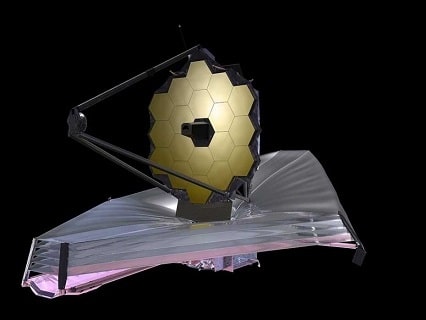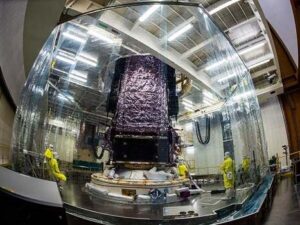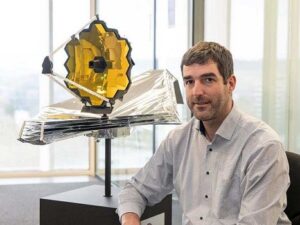
Visits: 0
– The launch of the James Webb Space Telescope is expected to take place in the next few days. For ETH Zurich physicist Adrian Glauser, who has been involved in two unspectacular but vital contributions to this ambitious project, this will end a long period of anxious anticipation.
Courtey EPFL by Felix Würsten: The launch of an Ariane rocket from the Guyana Space Center in the coming days will mark the realization of Adrian Glauser’s long-held dream. On board will be the James Webb Space Telescope – JWST, which has a mission scheduled to last up to ten years. Glauser, a physicist at ETH Zurich, has spent the past 18 years working on this challenging project, which is the continuation of the Hubble Space Telescope. Repeatedly, it has been postponed. “Over the years, I’ve learned to stay calm whenever there’s a setback,” he says. “But now that the launch really seems to be happening, I’m really excited!”
The mission
The James Webb Space Telescope (Webb) is the next major space science observatory after Hubble, designed to answer outstanding questions about the Universe and make groundbreaking discoveries in every field of astronomy. Webb will look further into our origins: from the formation of stars and planets to the birth of the first galaxies in the early Universe. Webb is an international partnership between NASA, ESA and CSA. The telescope will be launched on an Ariane 5 at the European spaceport in French Guiana.
The release
- Expected release date: December 25, 2021
- Launch site: European spaceport in French Guiana
- Launch vehicle: Ariane 5
- Orbit: Lagrange point 2, 1.5 million km from Earth
Real time Mirror Deployment: https://youtu.be/tlGTem8vkB0
Well protected from the sun
With a budget of about $10 billion, the JWST cost more than any other scientific project in the area of unmanned spaceflight. It is also one of the most complex space missions ever. Unlike its predecessor, the new telescope will not enter orbit around the Earth. Instead, it will be parked at the outer Lagrange point, L2, about 1.5 million kilometers into space. This is one of five points at which an artificial object will orbit the sun at the same speed as the Earth, without changing its position relative to the Earth.
As a location for a space telescope, it is ideal because at this distance it is much easier to protect it from solar radiation than if it were in orbit around the Earth. In the case of the JWST, this is vital as its four infrared instruments work correctly only when solar radiation and temperature fluctuations are kept to a minimum. Along with two infrared spectrographs, the JWST is also equipped with a near infrared camera, which is passively cooled to 50 kelvin, and a mid-infrared observation instrument called MIRI, which is actively cooled to 7 kelvin.

Extreme conditions
It was during his doctorate, in the former astronomy group of the Paul Scherrer Institute (PSI) in Villigen, that Glauser participated in the development of MIRI. He is now project manager for the Swiss mission contribution. “We worked closely with two industrial partners, Ruag Aerospace and Syderal, to develop a special cover made of aluminum and electrical connection cables for this specific instrument,” says Glauser. It may not sound particularly spectacular, but these components need to perform reliably for years to come at extremely low temperatures in space. This explains why a lot of work was done in its development.
Electrical connector cables are made of stainless steel and are much thinner than a human hair. This ensures that they transmit as little heat as possible to the instrument. Furthermore, they are insulated with a special plastic that does not become brittle at such low temperatures. “All the pieces are designed not to release atoms or molecules into space,” adds Glauser. “Otherwise they would condense on the MIRI mirror, which acts as a cold trap due to the extremely low temperature. And that, in turn, would compromise the observations. ” For this reason, the plastic used to cover the connecting cables was pre-treated before assembly, in order to avoid any gas release into space.
Fix is not an option
MIRI’s other Swiss part – its contamination control cap – must meet the same standard. This cover was designed to protect the MIRI during the cool-down phase, before the start of normal operation. It will also be used for further instrument calibration. “The mechanism of the contamination control lid must work reliably, otherwise the entire instrument will be inoperative,” says Glauser. “Repairs are out of the question as it is so far from Earth.”
The development of the two components brought several surprises. During inspection and approval of the contamination control cap, for example, it was found that 13 of the screws were coated with a material containing the heavy metal cadmium. In the eyes of the European Space Agency (ESA), this is a problematic material as it can become unstable in chemical compounds under vacuum. “I then had to develop a special measurement procedure to show that the screws have not released cadmium so far,” says Glauser.
Messages from the primordial universe
The new telescope, in which Simon Lilly, Professor of Experimental Astrophysics at ETH Zurich, was significantly involved, was designed with four mission objectives in mind, which require extremely sensitive instrumentation. Among other things, astrophysicists intend to use the JWST to go back to the origins of the universe in order to discover how the first stars and other structures formed after the Big Bang. In addition, scientists want to investigate planets that could contain life. “We won’t be using the JWST to look for new planets,” says Glauser, “but instead to take a closer look at those we’ve already identified. To do this, we are going to directly measure the light of the planets spectrally. ”
As a research physicist, Glauser will benefit from favorable access to observation time granted to the MIRI consortium. “This is the great advantage of being involved in the development of instruments like these. It will mean that we can start our projects before other research groups. ”

Thinking about the next mission
Glauser laments the end of the PSI astronomy group. “It’s true, we have a lot of know-how here at ETH. But if you want to participate in instrument development, you need well-established structures for the long term. And that’s not easy to get at a university”. A long-term horizon is essential for projects like these. In fact, Glauser is already involved in preparations for a mission, which will investigate exoplanets in a few decades that have a temperate climate and may have liquid water in their atmosphere or on their surface.
“I’m not going to witness the launch of this mission in my professional life,” says Glauser, “but it’s fascinating to think now about how a future telescope will have to be built to answer questions like these.” With this kind of design, he explains, there is no simple division between scientists, who just use the instruments, and engineers, who just build them: “You need people like me – instrument developers – who can define, based on a scientific perspective, what instruments should measure. ” At the same time, there is an added benefit to getting involved as a research institution: “You also have a say in what kind of research issues will be highlighted in the future.”
In anticipation of the first images
For now, however, Glauser is focusing on the short term. Shortly after the launch of the Ariane rocket, the critical phase of the JWST mission will begin. Over the course of a month’s journey to its destination, the telescope will progressively unfold in a complex maneuver until it reaches its full size. A period of several months will then follow during which the instruments cool down to the required temperature and are calibrated. If all the various components work as planned, the first scientific observations can begin next summer. Glauser, for example, is already eager to study the images the new telescope will deliver to Earth.
Other sources: The European Space Agency
Related article: The Top 10 Research Institutions Wide World
Leave a Reply